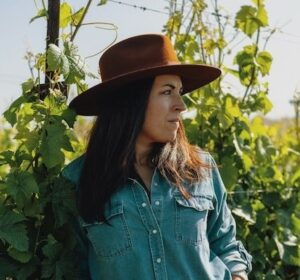
Jenny Scheid grew up in Northern California and began her wine journey by taking small sips of wine that her parents purchased while enjoying their trips to wine country. During high school, she learned that making wine was a possible career path and that she could study it when she went to college. She made wine from apple juice as a project for her high school biology class. After graduating from Cal Poly, she signed on for an internship with Schug Winery in Carneros, not knowing it would change her life forever. Here’s her story.
You grew up in Northern California. Tell us about your family, what it was like growing up in wine country, and what you dreamed of doing when the time came to choose your life path. And, of course, we always ask, if wine was a part of your family life.
I grew up just south of Napa and Sonoma when wine country was still in a young stage. My parents brought us with them on wine-tasting day trips to Napa and often met the owners. I was allowed small sips at home and they always let me taste or have a small glass when I was older if it was something I was interested in. My interest in the winery lifestyle grew and I learned it was something I could study in college and make a career of. In high school AP biology, we were required to perform our own, in-depth experiment and report on it. I decided to make wine from apple juice much to my teacher’s dismay, with the help of the Prager family’s direction. I remember they were so generous with their information and time they spent with me, even though I couldn’t legally enjoy wine yet. I loved the family atmosphere of their winery and was drawn further to the industry. When it came time to apply for colleges, I fell in love with the culture of ag at Cal Poly in SLO and my dream of attending came true when I was accepted.
Your first position in the wine industry was as an intern working for Schug Winery in the Carneros region. During that assignment, a life-changing event happened. Can you tell us about your fellow intern, Johannes, and what happened next?
Indeed, Schug was my first “out of college” job in wine after working in tasting rooms throughout my time at Cal Poly. It was a chance to really get to know the winemaking process since my degree was business and marketing-focused. I can never forget the day I pulled up to Schug, passing the brown-eyed, dark-haired, tall and handsome fellow intern, thinking “I thought Germans were blonde?!” Shows my ignorance! The “poor guy” didn’t know a soul here in California except for his college friends working for other wineries so I invited him to go to the City and show him around. After that, I learned a LOT about Germans and Germany in general by spending every single day with Johannes for three straight months. Needless to say, we had a lot of fun together, became very close and began dating by the end of our internship.
Johannes is from the Mosel region in Germany. He came to America for an internship at Schug as well. When the assignment ended, what were you both thinking?
There were lots of tears as I drove him to the Petaluma airporter to catch his flight home at the end of the internship, but it would not be the last I would see of him! We kept in touch for the next two years and he came back in 2011 for another internship at Schug. After spending some time working in Germany and New Zealand, we married in December of 2013. It’s been a wild ride of German-American living ever since!
You are certified as Level 2 with the Wine & Spirit Education Trust (WSET) and also Level 1 with the Court of Master Sommeliers. What motivated you to get formal training and certification? There are almost three hundred professionals that have achieved the title of “Master Sommelier” but only 25 are women. What was that experience like as a woman in a male-dominated organization?
During my time in San Luis Obispo, and right after the internship with Schug, I was involved in the World of Pinot Noir. During that time, I was able to meet many sommeliers who I helped with travel and other reservation plans. They were all very kind and helpful during the event and I kept in touch with many for some time afterward, meeting up from time to time; I was enamored by the world of wines. It seemed there were endless varietals and styles of winemaking and I wanted to learn about them all! I began working for an importer and we tasted so many rare wines together. By happenstance, one of those sommeliers from World of Pinot came into the retail shop and we got to talking. He offered me a spot in his upcoming Level 1 Class in Carmel, and I jumped at the opportunity. I did not pursue it past Level 1 since my interests don’t lie in wine service. A few years later, a colleague and I decided to enroll in the WSET 2 to further our education while working for that importer. I found it completely different than the CMS, but equally interesting. I may have pursued it had I stayed in the import business and may down the road; I believe it’s important to stay in tune with the grand world of wine while simultaneously spending so much time focusing on the winery or brand you’re working with. I love to have that perspective and be able to explain it to those who visit us.
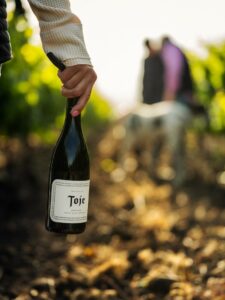 You recently launched your brand, Toje (pronounced Toi-yuh), which in German means “rootstock.” Why did you choose that name? Do customers have trouble pronouncing it? Your logo uses a “blackletter” or “Gothic script” style of font. Tell us about the design and the message you want to convey at first glance of the label.
You recently launched your brand, Toje (pronounced Toi-yuh), which in German means “rootstock.” Why did you choose that name? Do customers have trouble pronouncing it? Your logo uses a “blackletter” or “Gothic script” style of font. Tell us about the design and the message you want to convey at first glance of the label.
Toje is a really special word to our hearts, especially Johannes’ because the word is one from his town of approximately 700 inhabitants and is one word in a set of dialects. Even though the next town is less than a half mile away, that town will have a dialect set of words entirely unique to there too! I found this fascinating. And, when we started making wine, we couldn’t call it Scheid Vineyards for obvious reasons! Scheid Vineyards actually has a trademark on their name which is very rare and hard to get. We poured over so much literature, translations, foreign languages, and even experimented with combining words, but when we came across a small poster from his town with all these dialect words, Toje stuck out. It was perfect. Short, not too difficult to explain or pronounce and meaningful – we think about it as the rootstock growing from roots intertwining two cultures. We still get “TOE-GEE” which is hilarious to us, but we imagine with more brand recognition, “TOI-YUH” will stick. The blackletter font in the logo plays homage to the German root of the word and was developed by the small and very talented wine-focused marketing company, Gatto Rivera.
For several years you worked in marketing, sales, and hospitality for one Sonoma winery. The ability to sell wine rests on the ability to connect and draw people in. In that position what was the most exciting activity that you offered to help make emotional connections between the brand and your customers? Do you plan to offer those kinds of experiences to your customers?
Absolutely! Johannes, Patrick and I are “all in” on customer relationships and fully believe connection is first, followed by wine. In my past sales and hospitality role we greeted guests in the parking lot, so they immediately felt at ease. We shook hands, made eye contact, and asked a question about them to build trust and express our interest in them. Then we explained how the tour and tasting would go before diving into too much detail about the story, wines, etc. It’s all about catering to each party. Our time together and my “performance” depended on if it was their first time at the winery or if they’d been there several times already. Wine club members bringing friends love to be “on the inside” and we tried our very hardest to make them feel special because anyone coming to taste wine with us and more so hype it up for their friends was certainly very special.
In 2018 you started working with Sonoma Valley High School on a program targeting the future farmers and teaching kids how to grow grapes and make wine. How much interest is there from the students in this program? Do you sell the wine you make with the students and does the program pay for itself?
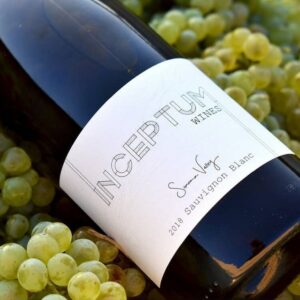 The program at SVHS was created to get students involved in the industry around them at a level they could participate in. The viticulture students, along with the FFA were participants in helping to care for the on-campus, experimental Sauvignon Blanc vineyard throughout the year and then harvest the grapes. We then took the fruit to press and continued the winemaking process. It was a very rewarding experience and really, a perfect way to enter the scene of “owning” a wine brand. Students’ interest ebbed and flowed as other activities and events at the high school took priority, but the students who showed up were always happy to be there. In 2020 when COVID hit, we had exceptional turnouts and I think kids realized how great it was to be out in nature with friends, even if you had to wear masks and “social distance.”
The program at SVHS was created to get students involved in the industry around them at a level they could participate in. The viticulture students, along with the FFA were participants in helping to care for the on-campus, experimental Sauvignon Blanc vineyard throughout the year and then harvest the grapes. We then took the fruit to press and continued the winemaking process. It was a very rewarding experience and really, a perfect way to enter the scene of “owning” a wine brand. Students’ interest ebbed and flowed as other activities and events at the high school took priority, but the students who showed up were always happy to be there. In 2020 when COVID hit, we had exceptional turnouts and I think kids realized how great it was to be out in nature with friends, even if you had to wear masks and “social distance.”
We did sell the wine we made under the label Inceptum, which means “initiative” in Latin. The community was supportive for the years we did this, and we barely broke even financially but never counted our time in the vineyard, so I suppose it didn’t, but the time was also very rewarding and we learned a ton. Now, with two children and a growing wine brand, we are grateful that another enthusiastic and talented winemaker has since stepped in for his own brand.
Tell us about Sweet Lane Vineyard, why you chose to work with Ed Grossi, and how you met him. What varieties are you making?
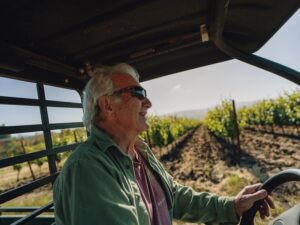 Sweet Lane Vineyard is a very special place in the Petaluma Gap, at the foot of Sonoma Mountain, with views of Gap’s Crown and Roberts Road Vineyards. Johannes has been buying Sauvignon Blanc from the same property for Schug, where he works as the winemaker, and discovered Ed also grew Pinot Noir and Chardonnay. The story is quite funny; because Johannes and I share so much, it was a surprise when he made a spontaneous detour on the way to the beach back in June of 2022 to Eddie’s vineyard to show me the Pinot Noir grapes. Ed has deep roots in agriculture, owning a nursery and really living for his land. He is also an incredibly hard worker, and we felt a connection with him as well as the site right away. We make a Pinot Noir and will soon release a Chardonnay from this vineyard.
Sweet Lane Vineyard is a very special place in the Petaluma Gap, at the foot of Sonoma Mountain, with views of Gap’s Crown and Roberts Road Vineyards. Johannes has been buying Sauvignon Blanc from the same property for Schug, where he works as the winemaker, and discovered Ed also grew Pinot Noir and Chardonnay. The story is quite funny; because Johannes and I share so much, it was a surprise when he made a spontaneous detour on the way to the beach back in June of 2022 to Eddie’s vineyard to show me the Pinot Noir grapes. Ed has deep roots in agriculture, owning a nursery and really living for his land. He is also an incredibly hard worker, and we felt a connection with him as well as the site right away. We make a Pinot Noir and will soon release a Chardonnay from this vineyard.
You recently won two People’s Choice Awards at the Petaluma Gap Wind to Wine Festival in August. Tell us about the wines that won and how that made you feel?
Surprised may not be the right word, because we know the wines are delicious (haha!) but really, to have been voted for this itself was very humbling. And to win, among so many great producers and in our first vintage, blew us away. We like to say that we make wines we like to drink to pair with foods we enjoy, and, according to those awards, we are in good company! Mostly, I felt so proud of Johannes. It was amazing to see the wines he dreamed of making come to life and to be loved by the attendees at Wind to Wine.
As you’ve mentioned, Johannes makes wine for Schug. We did a Spotlight on him in December 2022. Does he make the wine for Toje or do you? How many total cases do you produce? Where is the wine made?
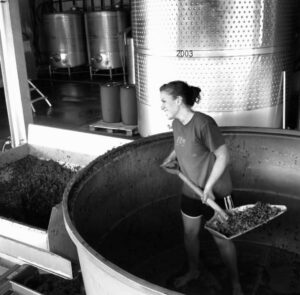 Johannes and I always joke about the whole idea of Toje. We always wanted to “have our own business” and having worked in marketing and hospitality, I said if he made some wine, I would love to sell it! But the truth is, we both are involved in making the wine. He takes me to scout the vineyards and sampling whenever possible and involves me in most aspects of the decision-making. I love to be in the cellar monitoring the wines and “doing the work.” Blending is also a team effort; there are so many decisions to be made along the way. I am constantly learning and thankful Johannes is there to show the way. This year, “my” wine will be a Petillant Naturel, hopefully from Riesling, and I’m looking forward to giving the full process my best shot.
Johannes and I always joke about the whole idea of Toje. We always wanted to “have our own business” and having worked in marketing and hospitality, I said if he made some wine, I would love to sell it! But the truth is, we both are involved in making the wine. He takes me to scout the vineyards and sampling whenever possible and involves me in most aspects of the decision-making. I love to be in the cellar monitoring the wines and “doing the work.” Blending is also a team effort; there are so many decisions to be made along the way. I am constantly learning and thankful Johannes is there to show the way. This year, “my” wine will be a Petillant Naturel, hopefully from Riesling, and I’m looking forward to giving the full process my best shot.
Our total production is less than 500 cases between all the varietals. We are so fortunate and grateful that the Schug family allows us to produce the wines and store our barrels there, which allows us to keep a close eye on their development!
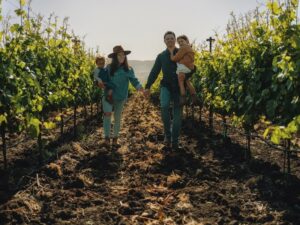 You and Johannes have two daughters, five-year-old Josie, and two-year-old Joliene. How do you balance family life and working for two different wineries? Do the girls enjoy time in the barrel room or out in the vineyard?
You and Johannes have two daughters, five-year-old Josie, and two-year-old Joliene. How do you balance family life and working for two different wineries? Do the girls enjoy time in the barrel room or out in the vineyard?
We don’t balance anything, more like juggling with fire and sharp objects! I LOVE being a mom and it’s the hardest thing to start a business when they are both full-time at home with me, which has been the case this past year. They will both go to school this Fall and I know already that I will struggle being away from them. I also know that this wine brand demands some great work in order leave a legacy for our girls. Having said that, both of them are no happier than when they are outside in the vineyard; Josie also loves performing punch downs with her Papa and Joliene is the best grape sampler out there already.
Which wine have you made that you are most proud of? What do you recommend it be served with? If there’s one variety you’d like to work with but haven’t yet, what would that be?
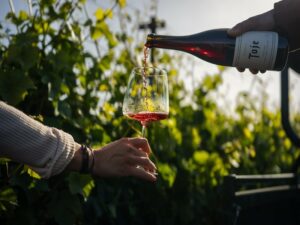 I’d say our Pinot is the wine we are most proud of because it’s what we’ve been aspiring to make forever! When we made the Inceptum Sauvignon Blanc, our customers would always ask “When are you making a Pinot” and we’d always say “When we find the right vineyard!” It’s been a long time in the works. We really enjoyed hearing the feedback at Wind to Wine, since that was really our first public debut – floral, pretty, great acidity, soft tannin, and structured; these were all traits we’d hope people would find in our wine, and traits we aspire to have. I love to let the wines shine with food, so, keeping it simple, roasted salmon, cheeses, or my absolute favorite dish – quail – are all great recommendations but there is so much potential to pair it with many diverse cuisines!
I’d say our Pinot is the wine we are most proud of because it’s what we’ve been aspiring to make forever! When we made the Inceptum Sauvignon Blanc, our customers would always ask “When are you making a Pinot” and we’d always say “When we find the right vineyard!” It’s been a long time in the works. We really enjoyed hearing the feedback at Wind to Wine, since that was really our first public debut – floral, pretty, great acidity, soft tannin, and structured; these were all traits we’d hope people would find in our wine, and traits we aspire to have. I love to let the wines shine with food, so, keeping it simple, roasted salmon, cheeses, or my absolute favorite dish – quail – are all great recommendations but there is so much potential to pair it with many diverse cuisines!
I am excited to make the Pet Nat this year because it’s always fun to have a sparkling around and maybe it’s not a new variety, but it is a new process; hopefully, that counts! In the long term, our dream is to make Riesling from Johannes’ family vineyard in the Mosel Valley, so we are looking at how we can make that happen!
